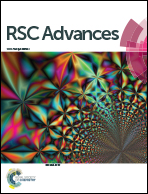Experimental study of dielectric property changes in DMSO–primary alcohol mixtures under low-intensity microwaves†
Abstract
By applying a low-intensity microwave to DMSO–primary alcohol mixtures, distinct dielectric property changes have been observed. The results indicated that the intermolecular interaction in these mixtures could be affected by the applied electric field with the order of 105 V m−1.


 Please wait while we load your content...
Please wait while we load your content...